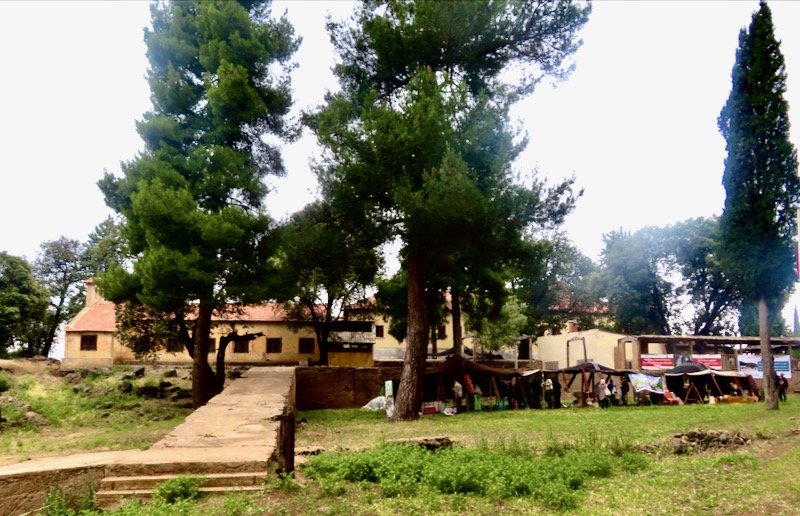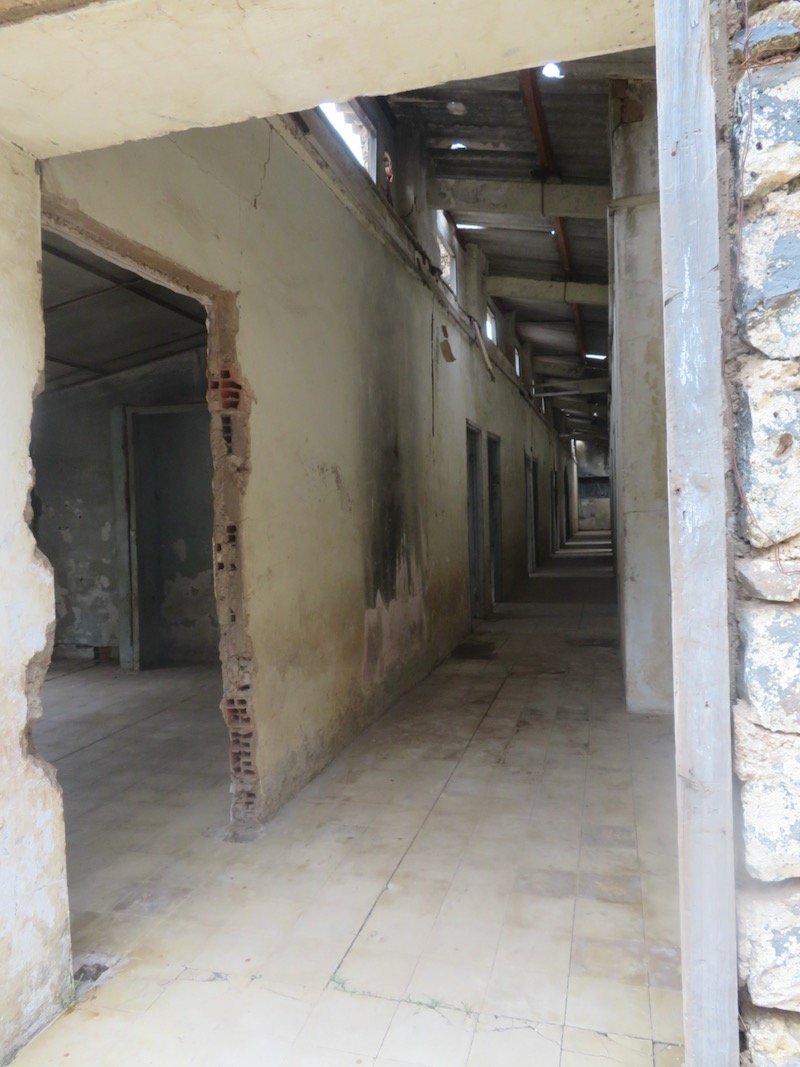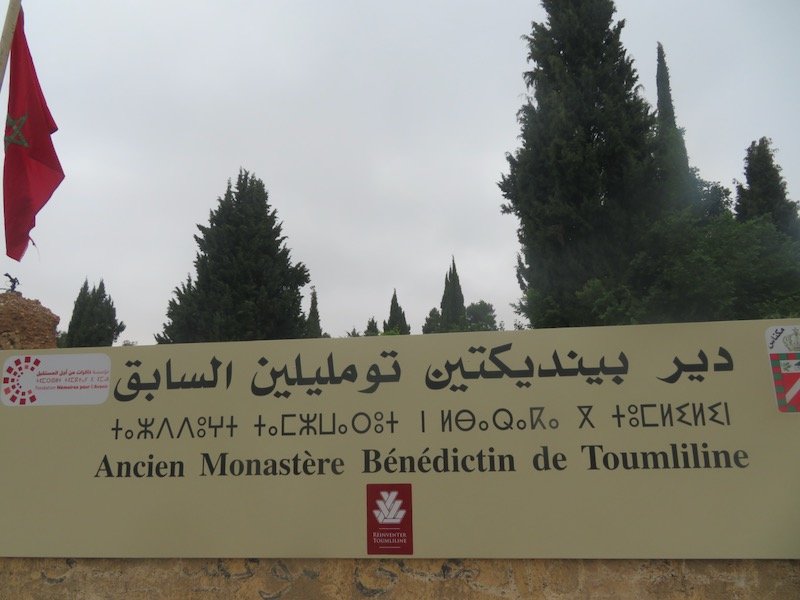‘Spirit of Toumliline’ Interfaith Inquiry Lives On 50 Years After Moroccan Monastery Closed
A general view of Toumliline Monastery in Morocco. Photo by Julia Bicknell.
As we wound up the road through the mid-Atlas hills in Morocco and turned into the clearing where the abandoned monastery lay, my mind immediately turned to one of the most moving and powerful films I’ve ever seen — “Of Gods and Men,” which won the Cannes Grand Prix in 2010 and Best Film in France’s Cesar Awards 2011 — about a similar monastery in Algeria.
I was in BBC World News when the real events dramatized in this film happened. Day after day through 1996, we reported on beheadings by the Algerian Armed Islamic Group, an extremist militia. Sometimes whole villages were wiped out. Among these was the killing of seven Trappist monks, all French expatriates, who — after warnings — had already debated their departure but decided to stay to serve the local Muslim community amid the threat of armed violence, in fulfillment of their priestly vows.
My professional connection with reporting this incident in Algeria meant that I went to see this film about the Cistercian monastery in Tibhirine. My spirit resonated with its powerful evocation of the conflict the monks experienced: Should they abandon their calling in order to save their lives here on earth, or choose to stay — trusting in God’s power to protect and save them, if that was his will?
Buildings at the Toumliline Monastery are badly in need of repairs. Photo by Julia Bicknell.
Now my first comment on arrival that day was, “This place reminds me of Tibhirine.” To which came the reply, “Did you know they actually filmed ‘Of Gods and Men’ here? In fact, the red stained glass windows in the disused chapel were put in by the film company people, who partly reconstructed some of the buildings while they were here for a couple of months.”
What had brought me to this off-the-tourist-trail place 90 kilometers (55.9 miles) south of Fes and Meknes? I had had no idea of its connection with “Of Gods and Men,” so I wasn’t film location-spotting.
In fact, there is a move to continue the rebuilding started by the film crew — not for more films but to return to the original vision for which this monastery, Toumliline, became internationally known during the 1950s and ‘60s.
Toumliline comes from the local Amazigh word for “white stones,” referring to a limestone source upstream of the monastery.
In 1947, a French Jesuit, inspired by the life of Charles de Foucauld, visited Morocco; he then invited Benedictine monks from an abbey near Toulouse to work in the then-French protectorate.
It’s fitting that Charles de Foucauld was canonized in May 2022, the very month that Toumliline was “relaunched.”
Foucauld was a French officer sent to Algeria in 1880. It was seeing the faith of Muslims there that started his journey back to his own Christian faith after he was thrown out of the army. At a time when travel in much of Morocco was forbidden to Europeans, he traveled there for 11 months disguised as a Jewish rabbi — guided by a Moroccan Jew — in order to learn about the country. He carried a tiny notebook and pencil to note the topography, the customs and the culture during his 3,000-kilometer (1,864-mile) journey, for which he’d prepared for over a year. He got to know local Muslim leaders and was welcomed by many; he suspected some guessed he was in fact a Christian, but they did not betray his true identity.
After his return to Paris, he eventually became a Trappist monk and returned to live in solitude on the Algeria/Morocco border until he was killed by anti-French Arab forces during World War I.
Eventually, in response to a formal invitation from the Catholic archbishop of Rabat in 1952, 20 Benedictine monks arrived in Toumliline to found the monastery of “Christ the King.” At that time, the mid-Atlas was already known for its insecurity, not least due to the growing nationalist movement of resistance to French rule. This foundation was linked to the break of the Catholic Church in Morocco with the protectorate authorities, so as to establish a dialogue with the local Muslim population.
The monks had been carefully chosen for their skills and interests: one, Jan de Reder, was a trained Dutch avant-garde architect (as new buildings would need to be constructed), another was a former Belgian diplomat, and another was a lawyer. While none knew the Berber language, one monk had grown up in Morocco, and two others had spent 15 years in the Middle East — these three spoke fluent Arabic.
But, for many, the European monks were seen as doubly suspect — running a Christian monastery in a predominantly Muslim land actively fighting to throw off French colonial rule.
So the monks were keen to differentiate themselves as Christians first and Europeans/French citizens second. Several had been active in the resistance during World War II. De Reder had forged identity papers to help Jews escape from the Netherlands. Another had been a prisoner of war in Germany; he could not bear to see prisoners being treated poorly.
In summer 1953, the French forced political prisoners to construct a water pipe between Toumliline and Azrou in oppressive heat. The monastery’s founding abbot, Denis Martin, served the prisoners and their overseers alike with mint tea. The French military commander, accusing the monks of playing politics, asked that all contact with the prisoners cease. Martin refused, saying, “Every time I meet people who suffer, I will relieve their suffering and, in doing so, I will not play politics.”
In addition to their daily disciplines of services and prayer, the monks first ran a small school and dispensary to meet local needs, but soon added a home for orphaned and abandoned children.
At one time, there were about 187 children attending.
This region of North Africa is long established as a revered seat of learning. The nearest city, Fes, is home to the oldest university in the entire world: Al Qarawiyyin, founded in the year 859 by Fatima al-Fihri, who inherited a large fortune after both her father and husband died. A devout Muslim, she used the funds to build a mosque that eventually became the largest Arab university in North Africa. It’s the most ancient university in the world still operating. Interestingly, one of its most famous scholars was the Jewish philosopher/physician Moses Maimonides, who moved to Fes from Cordoba in about 1159.
Al Qarawiyyin’s president has always been the most revered Islamic scholar in the region.
Local parents, wary of the new local school, asked him if it was wrong or dangerous to let their children be taught by the French monks, or indeed to go to the dispensary. “Absolutely not, these are men of God,” came the president’s reply. He had himself initiated Father Martin into Islamic studies; they had become firm friends.
Father Martin would organize impromptu teaching sessions on, for example, astronomy or music history. These meetings over glasses of tea broke down barriers between the French and the Moroccans who were, for the most part, locked in mutual misunderstanding — if not downright contempt for each other — given the geopolitical realities of the time.
With such support, Father Martin started organizing an annual pilgrimage to Toumliline for young Catholics, modeled on the famous Pentecost pilgrimage to Chartres Cathedral. With such themes as “Reflect on our role together: discover and respect, love and serve Moroccan culture” (50 participants, 1953), “How to connect with our Jewish and Muslim brothers and sisters” (200 participants, 1954) and “Warnings against syncretism by those insufficiently trained in faith in Christ” (500 participants, 1955), Toumliline’s reputation started to spread.
The monks soon established relations with the growing nationalist movement, led by the Istiqlal party. In 1955, summer camps for Istiqlal, forbidden by the French military authorities, found refuge in the monastery; all together, the groups organized activities and debates.
“International Meetings” were officially launched in August 1956 — shortly after France ended its colonial rule — under the patronage of the country’s soon-to-be head of state, King Mohamed V. His son, future Crown Prince Hassan, had been an early visitor to the monastery and wrote in the visitors’ book that year:
The Muslims wanted to learn from the monks, whose openness they value. You will see that those who are the most disposed to love (Muslim) believers are the men who declare themselves Christians, because they have priests and monks exempt from all pride.
But independence did not end French influence in Morocco; this included a continuing right to station troops there and a say in foreign policy. French settlers also maintained their rights and property.
With 300 youths already registered for the 1956 camp, their parents feared that Morocco’s Liberation Army would attack them. Father Martin took out ads in the papers encouraging the pilgrims to overcome their fears and trust the monks’ belief that the locals would respect and protect them.
Two hundred fifty young Catholics responded to the challenge; buses from Casablanca and Rabat arrived at the nearest village. As they walked, singing, the final 20 kilometers (12.4 miles) up through the cedar and oak forest to Toumliline, they could see armed horsemen on the ridge above. As the 250 pitched tent that evening, they could see a dozen armed Berbers still posted as guards in a circle around them — the Liberation Army was in fact protecting them by arrangement from two friends of Father Martin: the minister of the interior and the Rabat governor.
People from twelve nationalities participated in the first International Meeting that August ‘56; 850 Muslim, Jewish and Christian guests attended the opening session and the 52 lectures during the three weeks’ session.
In 1957, Crown Prince Hassan took over presidency of the organizing committee of the annual International Meeting. His welcome speech proclaimed, “In this country that … the King hopes to see become a bridge between Oriental and Occidental worlds … you, ladies and gentlemen, are at home … because the good man, the believer, the honest man, is everywhere at home.”
Moroccan Princess Lalia Aicha spoke about the role of women in building the new Morocco, including discussions about the wearing of the veil.
A workshop was co-organized by Cameroon and the University of Tokyo, while Prime Minister Nehru of India sent a woman representative.
Jean Lacouture described the atmosphere in the French daily newspaper Le Monde:
Strange and pleasant meeting of shorts and cassocks, light dresses and djellabas, blue jeans, straw hats and tarbouches. … What a festival, however, or what a congress would make it possible to hear in turn, as here, a Japanese professor of philosophy singing in an admirable tenor voice the lament of a wounded samurai; a Canadian troupe playing a Spanish farce in French, in the company of Moroccans; a royal princess presiding over a debate and half a dozen American philosophy professors sing together, in a palm grove in southern Morocco, the melodies of the Far West in the heart of the night, in front of an audience of dumbfounded nomads.
An American attendee summed up his impressions too:
There was a German who was teaching Spanish in Marrakech, and a Spaniard who was teaching music in Holland. There were poets, actresses, sociologists, theologians, photographers, seminarians, pharmacists, psychiatrists and engineers. There were Belgians with Italian names, Arabs with English names, Germans with French names. There was a turbaned Muslim theologian from Fez who was in fact French, a pop singer in blue-jeans who was a priest and a Persian from Harvard. There was an imam from the Grand Mosque of Fez, the Rector of the French College of Rome and the son of the President of the World Zionist Organization. There were also (people) from Princeton, Yale and Fordham Universities.
Two years later, in 1959, the number of attendees was still around 700. The theme of the debates was the economic development of the newly independent, preindustrialized countries, including discussion of, for instance, the role of trade unions in relation to Islamic teaching.
Photo by Julia Bicknell.
In 1960 — at the request of the sub-Saharan participants — the monks turned their attention to other African countries. They founded a monastery, St. Marie de Bouake, in the Ivory Coast and another in Koubri in Burkina Faso. At the same time, the monks’ presence ion Morocco was becoming more contentious. In 2016, Nina Kozlowski explained this in the magazine Zamane:
The euphoria of independence has given way to a merciless political struggle. The time (was) no longer for humanist unity or philosophical chatter about the future of the young Moroccan state. Some even say that several members of the Istiqlal opposed the very existence of the Toumliline monastery, surfing on the fear of proselytism.
The meetings started to be held without officials present until eventually, in 1964, the last one — ironically on “International Co-operation” — took place.
Then the monks were asked to stop running the boarding school and to move away. As the former archbishop of Rabat Vincent Landel explained in 2015, “It’s important to note that during these years, it was the presence in the Berber world that posed a problem; and at the time the decision was made to leave, His Majesty was ready to offer the monks a property of the same size, wherever they wanted … far or near a large city of their choice; but Father Denis had refused (and) the decision was made.”
The monastery was finally closed in 1968. Thus its abandoned buildings were available for “Of Gods and Men” to film in around 2010.
But the “Spirit of Toumliline” did not leave.
That brings me back to my visit in May this year.
A trip under the auspices of the European Commission’s “Global Exchange on Religion in Society,” first launched by former Commissioner Federica Mogherini, coincided with the official launch of the plan to rebuild Toumliline as a place for interfaith dialogue. This was hosted in Rabat by the Mohammadia League of Scholars. The following day, on a visit to the monastery itself, we met locals who will also be working with the Ministry of Forestry, bringing environmental awareness and sustainability into the plans for its new future.
Moroccan nongovernmental organization and civil society partners include the Future 21 Foundation and Memories for the Future, a nonprofit that does projects to preserve the interfaith collective Moroccan memory and its dissemination among the next generation.
Local groups are supported by the Catholic Diocese and Catholic Institute of Toulouse, France.
This story was first published in The Tablet and is republished with permission.
Julia Bicknell, a BBC journalist for 30 years, now focuses on the global Church under pressure.



